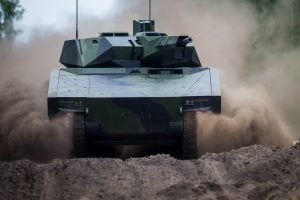
AUSA 2019: True, only one competitor, General Dynamics, delivered a prototype by the Oct. 1 deadline for the Army’s program to replace the Reagan-era M2 Bradley troop carrier. But it’s ludicrously too early to talk about the program potentially failing, as a Breaking Defense headline suggested last week, the head of Army Futures Command said this afternoon. The Army has just begun studying GD’s offering, Gen. John “Mike” Murray said, and other companies will have another chance to compete in 2023.
Meanwhile, the other part of the Army’s Next Generation Combat Vehicles portfolio – its experiments towards a family of Robotic Combat Vehicles – is actually advancing faster than expected, as NGCV director Brig. Gen. Richard Ross Coffman told Breaking Defense in a recent interview.

Even under a new Army Secretary and Chief of Staff, Gen. Murray told reporters here, “there are zero changes in terms of our priorities.” Those are the Big Six capabilities, ranging from long-range missiles to new assault rifles, of which the Next Generation Combat Vehicle is No. 2.
“NGCV is still focused on Bradley replacement [and] Robotic Combat Vehicles in three classes, light medium and heavy,” Murray continued. “In terms of experimentation with those, we are in the same place with NGCV we were a year and half ago.”
But what about rising concern in Congress, the defense industry, and the Army itself about the surprise disqualification of Rheinmetall for not delivering its OMFV prototype to the Army on time? That seems to leave the Army with only one qualified competitor for the next phase, an Engineering & Manufacturing Development (EMD) contract. Yes, there’ll be another competition in 2023 to actually start building OMFVs – the Low Rate Initial Production (LRIP) phase – but with GD the sole recipient of EMD funding and feedback, it will have an intimidating advantage. There’ve been suggestions we need to slow the program down…
“Can I answer the question?” Gen. Murray said. “We are prototyping, so I think this discussion is very premature until we understand what we have.”
“No. 2, Sydney, we have been exceptionally consistent and open with industry for better than a year and a half [about] what it is we need, when bid samples were due, and we had a competitor that did not make that,” he went on. “It really put the Army in a hard place, because we could either delay — and then face possibly a protest — or we could stick with what we’ve been saying for a year and a half.”
(Protests to the GAO from disappointed bidders have become routine, and they’re just as routinely dismissed. But if one competitor meets the deadline and another gets an extension, that’s the kind of inconsistent treatment that GAO takes seriously.)
“I’ve got all the reasons the 1 Oct. deadline wasn’t made, but that deadline has been there for the better part of a year,” Murray said. “[And] as you mentioned, if there’s somebody out there that’s got a viable solution to what we’ve said that we want consistently, it’s opened up again for competition when we get to the LRIP phase.”

